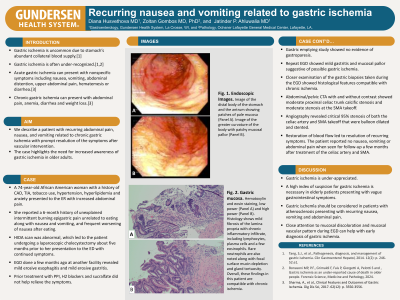Tuesday Poster Session
Category: Stomach
P5067 - Recurring Nausea and Vomiting Related to Chronic Gastric Ischemia
Tuesday, October 29, 2024
10:30 AM - 4:00 PM ET
Location: Exhibit Hall E

Has Audio

Diana Husvethova, MD
Houston Methodist
Houston, TX
Presenting Author(s)
Diana Husvethova, MD1, Jatinder P. Ahluwalia, MD2
1Houston Methodist, Houston, TX; 2Emplify Health, La Crosse, WI
Introduction: Gastric ischemia is uncommon due to stomach’s abundant collateral blood supply and thus is often under-recognized. Mechanical, vascular, and systemic causes have been reported to cause gastric ischemia. Acute gastric ischemia can present with nausea, vomiting, abdominal distension and upper GI bleeding. Although chronic gastric ischemia is reported to present with some of the similar symptoms in addition to abdominal pain, anemia, diarrhea and weight loss, it is usually under-appreciated. We describe a patient with recurring abdominal pain, nausea and vomiting related to gastric ischemia with prompt resolution of symptoms after vascular intervention.
Case Description/Methods: A 74-year-old African American woman with history of CAD, TIA, smoking, hypertension, hyperlipidemia and anxiety was seen in the ER with increased abdominal pain. She also had a 6-month history of unexplained intermittent burning epigastric pain not related to eating, nausea and vomiting. Prior treatment with PPI, H-2 blocker and sucralfate did not alleviate her symptoms. Her previous workup included an EGD at another facility that revealed mild erosive esophagitis and mild erosive gastritis. Her symptoms had continued despite undergoing a laparoscopic cholecystectomy for an abnormal HIDA scan. A gastric emptying study showed no evidence of gastroparesis. Repeat EGD showed mild gastritis and mucosal pallor suggestive of possible gastric ischemia. CTA abdomen/pelvis (with and without contrast) showed moderate proximal celiac trunk calcific stenosis and moderate stenosis at the superior mesenteric artery takeoff. Angiography revealed critical 95% stenosis of both the celiac artery and superior mesenteric artery takeoff which were balloon dilated and stented with resultant improvement in symptoms. When seen in the clinic for follow-up, she reported no further nausea, vomiting or abdominal pain.
Discussion: Although uncommon due to rich collateral blood supply of the stomach, chronic gastric ischemia can present with nausea, vomiting and abdominal pain. Endoscopic findings in gastric ischemia vary based on the chronicity and the underlying cause. However, careful attention to mucosal coloration and the finding of pale mucosa can lead to early diagnosis and intervention as was done in the case of our patient with complete resolution of recurring nausea and vomiting along with burning epigastric pain.
Disclosures:
Diana Husvethova, MD1, Jatinder P. Ahluwalia, MD2. P5067 - Recurring Nausea and Vomiting Related to Chronic Gastric Ischemia, ACG 2024 Annual Scientific Meeting Abstracts. Philadelphia, PA: American College of Gastroenterology.
1Houston Methodist, Houston, TX; 2Emplify Health, La Crosse, WI
Introduction: Gastric ischemia is uncommon due to stomach’s abundant collateral blood supply and thus is often under-recognized. Mechanical, vascular, and systemic causes have been reported to cause gastric ischemia. Acute gastric ischemia can present with nausea, vomiting, abdominal distension and upper GI bleeding. Although chronic gastric ischemia is reported to present with some of the similar symptoms in addition to abdominal pain, anemia, diarrhea and weight loss, it is usually under-appreciated. We describe a patient with recurring abdominal pain, nausea and vomiting related to gastric ischemia with prompt resolution of symptoms after vascular intervention.
Case Description/Methods: A 74-year-old African American woman with history of CAD, TIA, smoking, hypertension, hyperlipidemia and anxiety was seen in the ER with increased abdominal pain. She also had a 6-month history of unexplained intermittent burning epigastric pain not related to eating, nausea and vomiting. Prior treatment with PPI, H-2 blocker and sucralfate did not alleviate her symptoms. Her previous workup included an EGD at another facility that revealed mild erosive esophagitis and mild erosive gastritis. Her symptoms had continued despite undergoing a laparoscopic cholecystectomy for an abnormal HIDA scan. A gastric emptying study showed no evidence of gastroparesis. Repeat EGD showed mild gastritis and mucosal pallor suggestive of possible gastric ischemia. CTA abdomen/pelvis (with and without contrast) showed moderate proximal celiac trunk calcific stenosis and moderate stenosis at the superior mesenteric artery takeoff. Angiography revealed critical 95% stenosis of both the celiac artery and superior mesenteric artery takeoff which were balloon dilated and stented with resultant improvement in symptoms. When seen in the clinic for follow-up, she reported no further nausea, vomiting or abdominal pain.
Discussion: Although uncommon due to rich collateral blood supply of the stomach, chronic gastric ischemia can present with nausea, vomiting and abdominal pain. Endoscopic findings in gastric ischemia vary based on the chronicity and the underlying cause. However, careful attention to mucosal coloration and the finding of pale mucosa can lead to early diagnosis and intervention as was done in the case of our patient with complete resolution of recurring nausea and vomiting along with burning epigastric pain.
Disclosures:
Diana Husvethova indicated no relevant financial relationships.
Jatinder Ahluwalia indicated no relevant financial relationships.
Diana Husvethova, MD1, Jatinder P. Ahluwalia, MD2. P5067 - Recurring Nausea and Vomiting Related to Chronic Gastric Ischemia, ACG 2024 Annual Scientific Meeting Abstracts. Philadelphia, PA: American College of Gastroenterology.
